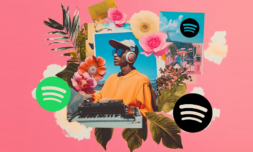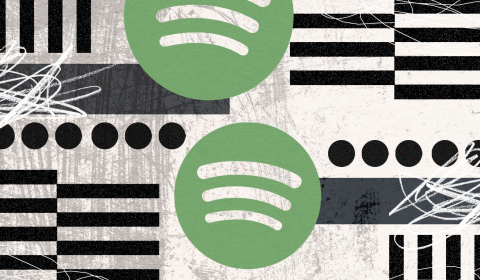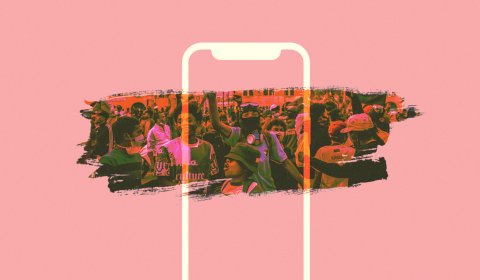What’s trending this autumn?
Welcome to the latest edition of The Gen Zer. This week, we take a look at Dopamine Autumn and the various trends that have been emerging recently, from YouTube’s New Wave to ‘dopamine menus’ on TikTok. Read on for more 🙂
My colleague Sofia recently wrote a piece on the ‘dopamine fasting’ trend and whether there’s any evidence backing it up. In short, the idea is to avoid activities like checking social media which (along with things like gambling, watching porn and doing drugs) releases large amounts of dopamine in your brain, getting you hooked and desensitised towards the more normal things in life — like going for a walk, reading a book, or even doing the washing up.
The science behind this is still somewhat light on the details, although many people are swearing by the trend, citing improved attention spans and general happiness levels after quitting social media and other addictive apps. Isabella Oggioni recently spoke with Dazed about how, with a growing focus on mindfulness and self-care, along with our generation’s tendency to label things, it looks like we’re entering a ‘Dopamine Autumn’.
The ‘dopamine menu’ trend on TikTok is part of this. In the videos, users create menus where the starters, mains and desserts are all activities designed to boost your happiness levels with some slow, healthy habits. Your starter might be making your bed. The main course then might be cooking dinner for a friend, with a dessert of watching your favourite film to finish.
@richinlifeco No cause we are obsessed with ✨dopamine menus✨ #dopaminemenu #dopamine #demure #richinlife #lifelessons ♬ EP 157 note to self by payton sartain podcast – Payton Sartain
This isn’t the first time that the idea of dopamine has been used as part of a happiness-related trend, of course. Dopamine dressing, for instance, had people picking out brightly coloured outfits to spark some greater joy into their day-to-day life. Dopamine has long had a role in our collective imagination as a ‘happiness chemical’ and a symbol for joy, even if its actual biological role is generally oversimplified and not fully understood by most of us.
The idea of Dopamine Autumn made me think of a number of other trends that we’ve been seeing lately. Over on YouTube, movements like the ‘YouTube New Wave’ are putting a greater emphasis on storytelling and slower, authentic content that avoids the clickbait-heavy, fast-paced content of something like a MrBeast video. (MrBeast himself has even said that he’s slowing down his videos, yelling less, and focusing more on personality and storytelling. The era of quick cuts seems to be dying out.)
The elephant in the room is bright green, of course. Marketers and brands have been moving in the other direction this summer — towards a more freeform, unhinged approach to engaging with consumers. I’m sure you’ve seen the usual buzz around brands like Duolingo and Ryanair, which have massively improved their online followings by leaning into these less professional, less held back personas. Similarly, smaller brands like Nutty Butter have racked up millions of views and hundreds of thousands of followers with videos that possess a distinct, dopamine-flooding style. Some of their videos can seem completely unhinged.
@officialnutterbutterit is unknown♬ original sound – nutter butter
There’s an interesting mix when it comes to the different trends that brands and consumers are adopting. Consumers are increasingly seeming to want things that feel real: long-form over short-form, analogue instead of digital. And yet brands are going the other way, shedding a corporate reservedness to embrace the trendy, the immediate, and the downright strange. Both creators and marketers are trying to find ways to look like they’re not trying to market to you at all.
The danger for brands is the incredibly short attention span of social media. When I came across Nutty Butter’s TikTok strategy the other morning I found it interesting and fun, but if they’re still doing the same thing in six months time, or in three years? Relying on virality is a dangerous tactic, one that’s never going to keep paying dividends forever. Building a brand requires more than that; as cliché as it sounds, you still need to build community, and you need a vision as part of that. Following trends isn’t going to be enough.
Duolingo is one brand that has turned a few viral moments into something long-lasting. Since the brand’s very first viral videos it has doubled down and built up a whole persona around the mascot, the green owl called Duo. The key thing, according to Zaria Parvez (the brains behind the brand’s unhinged marketing strategies) is to focus on entertaining potential users rather than explicitly marketing to them. Hence the TikToks of Duo twerking and some truly chaotic replies to users.

Alternatively, Abercrombie & Fitch is one brand that’s ‘grown up’ and moved away from the younger-leaning trends altogether. After struggling financially, it’s come back to have a record-breaking year and even out-performing Nvidia (its shares increased to a 459% gain over the past year, outperforming Nvidia’s 187% stock growth in the same period). The main changes it introduced with its rebrand were to ditch things like the heavily-perfumed, loud-music store designs, the focus on logos and ‘trendy’ pieces, and the picture-perfect product models. Instead, Abercrombie brought in a greater focus on inclusivity, a more modern, laid-back approach to its stores, and, crucially, a more minimalist and timeless approach to its clothing, with modern fits and high-quality materials that have a longer term wearability. After all, a logo is going to go out of fashion sooner or later, but a well-made winter coat?
As fast fashion brands like Shein continue to face a growing number of challenges and questions, it’ll be interesting to see whether Abercrombie’s annus mirabilis continues into the autumn. Given that many people associate the season with oversized sweaters, woollen coats, and timeless styles, I think they’ll be fine. Shein, however, has no ties to culture, no community, and no heritage. Like the dopamine-flooding micro-trends, I wouldn’t be altogether surprised if it comes and goes without anyone actually missing it.
So which way are we going? Are we entering a healthy, rebalance-your-dopamine-receptors kind of autumn, or a dopamine-flooding, jump-on-all-the-trends one? I guess the answer is it’s a mixture of both.
There’s a certain irony in ‘dopamine menus’ being a TikTok trend, of course. With every new video, your brain expects the possibility of something new and exciting and so releases a flood of dopamine to help you deal with this new thing (or something along those lines — like I said, the science is a little sketchy). Doomscrolling through short form content is about as overstimulating and desensitising as you can get, so there’s perhaps a certain dissonance in consuming ‘dopamine menu’ videos on TikTok.
![]()
“With cocaine you run out of money, but TikTok is indefatigable.”
— from a Guardian article on digital dependency
![]()
But concerning the trend itself, it is arguably a positive one. At its best, Dopamine Autumn is about building healthy habits — the ones that make you feel good — and dropping the ones that leave you feeling gross and burned out. It’s a reappraisal of how you spend your time and how the things you do affect you.
Similarly, there’s been an explosion in apps that place restrictions on our access to social media and our phones in general. Sometimes a friend will open Instagram to show me something, only to be greeted by a countdown that forces them to wait and reconsider whether they actually want to access the app. Similarly I know lots of people who keep their phones in black-and-white mode for most of the time, making everything on the screen less interesting and generally making them spend less time on their phone. Keeping tabs on your screentime has become increasingly normalised.
The brands continue to go for bright colours, wacky edits, and unhinged content (and there’s nothing wrong with that; we all need a little fun and silliness sometimes) but for Gen Z, there seems to be a growing awareness that a lot of this — our habits, the way we feel — is our responsibility. If something is addictive, then we need to create barriers to prevent us from accessing that thing when we’re feeling tired and weak. If you struggle to do things like making your bed or cooking a healthy meal, then maybe you need to reframe that activity into something fun and rewarding, perhaps by creating a ‘menu’. In many ways, it’s simply about being more self-aware and intentional with the things we do — with the time we spend, the energy we have, and the attention we give.
See also:
- Gen Z is healthy and boring
- Can book clubs help solve Gen Z loneliness?
- How Spotify are winning with Gen Z
Gen Z around the Web
Kids in Sweden to have less screen-time and more school-time (thred)
Scandinavia has some of the best educational outcomes in the world, despite not having an obsession with grades and cramming for exams. Sweden is now continuing this more holistic approach to education with moves that will see a greater focus on things like printed books and reading, and much less of a focus on tablets and online research, amidst concern about the negative effects of technology. It’s part of a wider trend that we’re seeing here in the UK, with calls for measures like banning social media for young teens. Read more
I really can’t tell if you’re serious (the atlantic)
Nutty Butter isn’t the only account posting somewhat confusing content. Increasingly, there seem to be more and more videos that are just kind of . . . strange, like a video of a woman telling a straight-faced story about getting proposed to at a Taylor Swift concert. For the audience, it can be pretty captivating; we hate a mystery, right? Are they being serious? For the content creator, it’s a pretty good way to get more views, more comments, and more engagement. Nothing on the internet is real guys. Read more
Conscious unbossing: why gen Z are refusing to become managers (fortune)
There have been a number of articles this week about ‘conscious unbossing.’ Recent research has found that more than half of young workers in Britain don’t want a middle-management position, having witnessed millennials in those positions get hyper-stressed and burned out. Job stability is another aspect — middle managers are often the first served up for the firing line, especially in the struggling tech sector (12,000 managers at Google lost their jobs just last year, for example). We continue to see Gen Z take a very different approach to their careers compared to previous generations. Read more
How Sally Rooney’s new novel ‘Intermezzo’ became a celebrity obsession (msnbc)
Before a novel is released, a number of ‘galley’ copies are typically sent out to journalists and others in the industry. It’s a fairly standard procedure and there’s usually not too much to say about it, but with Sally Rooney’s new novel the galley copy has itself becoming a marketing holy grail — acting as a status symbol for celebrities and those with enough connections to get their hands on one. Read more
![]()
That’s all for this week! Make sure to subscribe for the latest on Gen Z and youth culture, and check out The Common Thred for a weekly roundup of the latest news, trends and thought pieces.

















